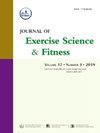Effects of high-intensity interval training and moderate-intensity continuous training on the functioning of attentional networks and heart rate variability in healthy young adults
IF 2.4
2区 医学
Q2 SPORT SCIENCES
引用次数: 0
Abstract
Objective
Human attentional mechanisms comprise three distinct networks: alerting, orienting, and executive control. Studies assessing the acute effects of moderate-intensity continuous training (MICT) on these networks have yielded inconsistent results. Similarly, the acute effects of high-intensity interval training (HIIT) on these networks remain unclear. Therefore, this study investigated the effects of HIIT and MICT on the functioning of attentional networks and explored the relationship between heart rate variability (HRV) and these networks in healthy young adults.
Methods
Thirty-six healthy college students completed HIIT, MICT, and a resting (CON) session in a randomized cross-over design. The HIIT protocol comprised 10 × 1-min bouts at 100 % peak power output (Wpeak) with 1 min of active recovery at 20 % Wpeak. The MICT protocol was applied at 40 % Wpeak for 30 min. Functioning of the attentional networks was assessed post-intervention using the Attention Network Test for Interactions (ANT-I). HRV was recorded pre- and post-exercise/rest and during the ANT-I.
Results
HIIT significantly reduced the alerting function compared to CON (p = 0.017) but enhanced executive control compared to CON (p = 0.001) and MICT (p = 0.002). Following HIIT, immediate reductions in the log-transformed root mean square of successive differences (LnRMSSD) were significantly correlated with alerting (r = 0.554, p = 0.001) and executive control functions (r = 0.412, p = 0.016). Task-related LnRMSSD reductions also correlated with alerting (r = 0.424, p = 0.013) and executive control functions (r = 0.356, p = 0.039).
Conclusion
A single session of HIIT selectively modulated the functioning of attentional networks, decreasing alerting function while enhancing executive control. These effects were partly mediated by increased arousal resulting from parasympathetic withdrawal.
高强度间歇训练和中等强度连续训练对健康年轻人注意网络功能和心率变异性的影响
人类的注意机制包括三个不同的网络:警报、定向和执行控制。评估中等强度连续训练(MICT)对这些神经网络的急性影响的研究得出了不一致的结果。同样,高强度间歇训练(HIIT)对这些神经网络的急性影响尚不清楚。因此,本研究调查了HIIT和MICT对健康年轻人注意网络功能的影响,并探讨了心率变异性(HRV)与这些网络之间的关系。方法采用随机交叉设计,36名健康大学生完成HIIT、MICT和休息(CON)。HIIT方案包括在100%峰值功率输出(Wpeak)下进行10次1分钟的回合,在20%峰值功率输出时进行1分钟的主动恢复。在40%的峰值下使用MICT协议30分钟。干预后使用注意网络相互作用测试(ANT-I)评估注意网络的功能。记录运动前、运动后/休息和ANT-I期间的HRV。结果与CON相比,shiit显著降低了患者的报警功能(p = 0.017),但与CON (p = 0.001)和MICT (p = 0.002)相比,shiit增强了患者的执行控制功能。HIIT后,对数变换后的连续差异均方根(LnRMSSD)的立即降低与报警(r = 0.554, p = 0.001)和执行控制功能(r = 0.412, p = 0.016)显著相关。与任务相关的LnRMSSD减少也与警报(r = 0.424, p = 0.013)和执行控制功能(r = 0.356, p = 0.039)相关。结论单次HIIT有选择性地调节了注意网络的功能,降低了警报功能,增强了执行控制。这些影响部分是由副交感神经戒断引起的觉醒增加介导的。
本文章由计算机程序翻译,如有差异,请以英文原文为准。
求助全文
约1分钟内获得全文
求助全文
来源期刊
CiteScore
5.10
自引率
3.60%
发文量
54
审稿时长
31 days
期刊介绍:
The Journal of Exercise Science and Fitness is the official peer-reviewed journal of The Society of Chinese Scholars on Exercise Physiology and Fitness (SCSEPF), the Physical Fitness Association of Hong Kong, China (HKPFA), and the Hong Kong Association of Sports Medicine and Sports Science (HKASMSS). It is published twice a year, in June and December, by Elsevier.
The Journal accepts original investigations, comprehensive reviews, case studies and short communications on current topics in exercise science, physical fitness and physical education.

 求助内容:
求助内容: 应助结果提醒方式:
应助结果提醒方式:


